Nian Liu
RAGNet: Large-scale Reasoning-based Affordance Segmentation Benchmark towards General Grasping
Jul 31, 2025


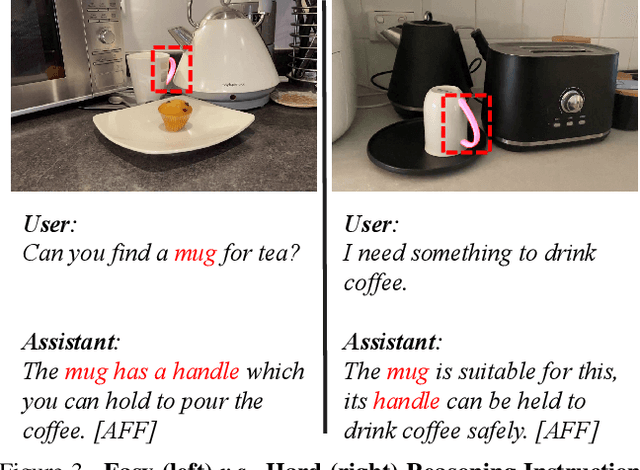
Abstract:General robotic grasping systems require accurate object affordance perception in diverse open-world scenarios following human instructions. However, current studies suffer from the problem of lacking reasoning-based large-scale affordance prediction data, leading to considerable concern about open-world effectiveness. To address this limitation, we build a large-scale grasping-oriented affordance segmentation benchmark with human-like instructions, named RAGNet. It contains 273k images, 180 categories, and 26k reasoning instructions. The images cover diverse embodied data domains, such as wild, robot, ego-centric, and even simulation data. They are carefully annotated with an affordance map, while the difficulty of language instructions is largely increased by removing their category name and only providing functional descriptions. Furthermore, we propose a comprehensive affordance-based grasping framework, named AffordanceNet, which consists of a VLM pre-trained on our massive affordance data and a grasping network that conditions an affordance map to grasp the target. Extensive experiments on affordance segmentation benchmarks and real-robot manipulation tasks show that our model has a powerful open-world generalization ability. Our data and code is available at https://github.com/wudongming97/AffordanceNet.
TAViS: Text-bridged Audio-Visual Segmentation with Foundation Models
Jun 13, 2025Abstract:Audio-Visual Segmentation (AVS) faces a fundamental challenge of effectively aligning audio and visual modalities. While recent approaches leverage foundation models to address data scarcity, they often rely on single-modality knowledge or combine foundation models in an off-the-shelf manner, failing to address the cross-modal alignment challenge. In this paper, we present TAViS, a novel framework that \textbf{couples} the knowledge of multimodal foundation models (ImageBind) for cross-modal alignment and a segmentation foundation model (SAM2) for precise segmentation. However, effectively combining these models poses two key challenges: the difficulty in transferring the knowledge between SAM2 and ImageBind due to their different feature spaces, and the insufficiency of using only segmentation loss for supervision. To address these challenges, we introduce a text-bridged design with two key components: (1) a text-bridged hybrid prompting mechanism where pseudo text provides class prototype information while retaining modality-specific details from both audio and visual inputs, and (2) an alignment supervision strategy that leverages text as a bridge to align shared semantic concepts within audio-visual modalities. Our approach achieves superior performance on single-source, multi-source, semantic datasets, and excels in zero-shot settings.
Unsupervised Learning for Class Distribution Mismatch
May 11, 2025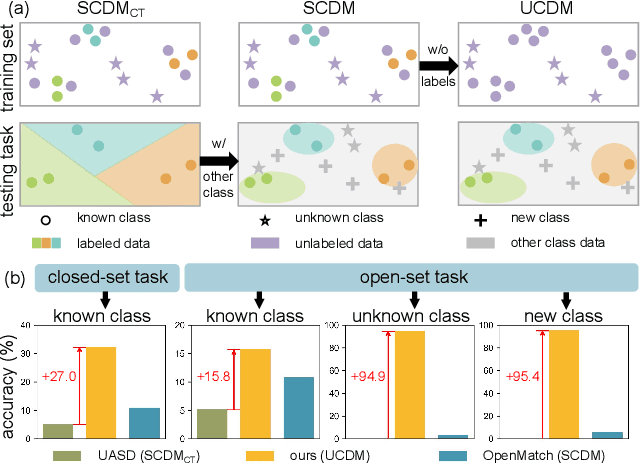

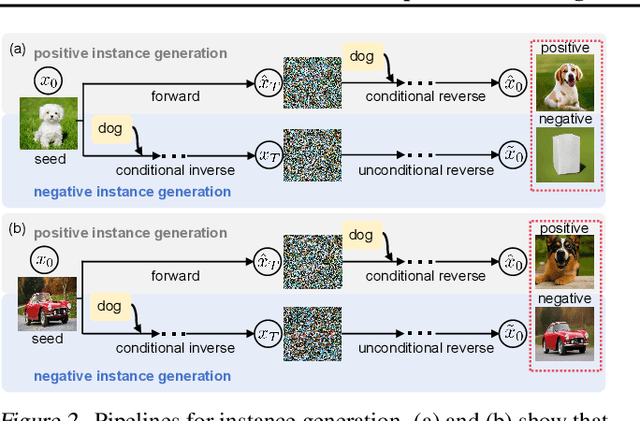

Abstract:Class distribution mismatch (CDM) refers to the discrepancy between class distributions in training data and target tasks. Previous methods address this by designing classifiers to categorize classes known during training, while grouping unknown or new classes into an "other" category. However, they focus on semi-supervised scenarios and heavily rely on labeled data, limiting their applicability and performance. To address this, we propose Unsupervised Learning for Class Distribution Mismatch (UCDM), which constructs positive-negative pairs from unlabeled data for classifier training. Our approach randomly samples images and uses a diffusion model to add or erase semantic classes, synthesizing diverse training pairs. Additionally, we introduce a confidence-based labeling mechanism that iteratively assigns pseudo-labels to valuable real-world data and incorporates them into the training process. Extensive experiments on three datasets demonstrate UCDM's superiority over previous semi-supervised methods. Specifically, with a 60% mismatch proportion on Tiny-ImageNet dataset, our approach, without relying on labeled data, surpasses OpenMatch (with 40 labels per class) by 35.1%, 63.7%, and 72.5% in classifying known, unknown, and new classes.
Adapting In-Domain Few-Shot Segmentation to New Domains without Retraining
Apr 30, 2025Abstract:Cross-domain few-shot segmentation (CD-FSS) aims to segment objects of novel classes in new domains, which is often challenging due to the diverse characteristics of target domains and the limited availability of support data. Most CD-FSS methods redesign and retrain in-domain FSS models using various domain-generalization techniques, which are effective but costly to train. To address these issues, we propose adapting informative model structures of the well-trained FSS model for target domains by learning domain characteristics from few-shot labeled support samples during inference, thereby eliminating the need for retraining. Specifically, we first adaptively identify domain-specific model structures by measuring parameter importance using a novel structure Fisher score in a data-dependent manner. Then, we progressively train the selected informative model structures with hierarchically constructed training samples, progressing from fewer to more support shots. The resulting Informative Structure Adaptation (ISA) method effectively addresses domain shifts and equips existing well-trained in-domain FSS models with flexible adaptation capabilities for new domains, eliminating the need to redesign or retrain CD-FSS models on base data. Extensive experiments validate the effectiveness of our method, demonstrating superior performance across multiple CD-FSS benchmarks.
CONDA: Condensed Deep Association Learning for Co-Salient Object Detection
Sep 04, 2024
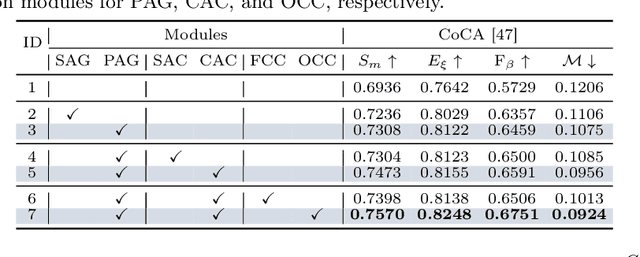
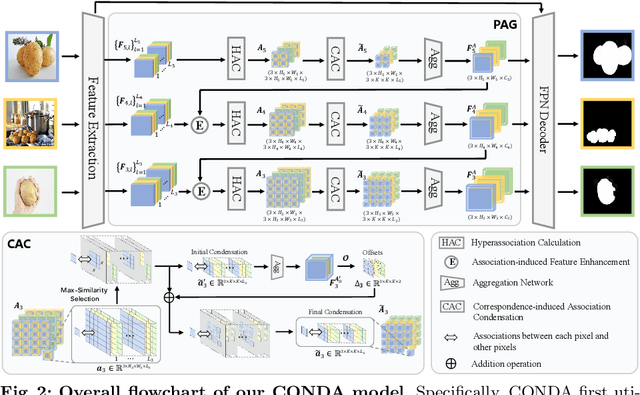
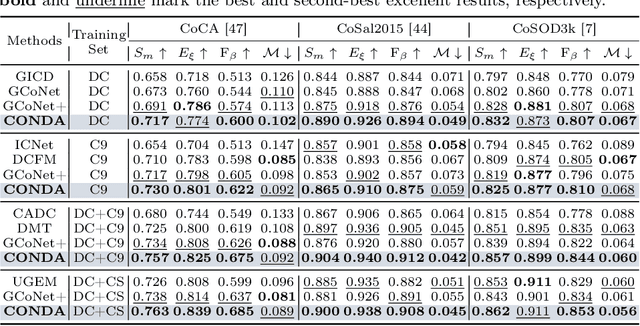
Abstract:Inter-image association modeling is crucial for co-salient object detection. Despite satisfactory performance, previous methods still have limitations on sufficient inter-image association modeling. Because most of them focus on image feature optimization under the guidance of heuristically calculated raw inter-image associations. They directly rely on raw associations which are not reliable in complex scenarios, and their image feature optimization approach is not explicit for inter-image association modeling. To alleviate these limitations, this paper proposes a deep association learning strategy that deploys deep networks on raw associations to explicitly transform them into deep association features. Specifically, we first create hyperassociations to collect dense pixel-pair-wise raw associations and then deploys deep aggregation networks on them. We design a progressive association generation module for this purpose with additional enhancement of the hyperassociation calculation. More importantly, we propose a correspondence-induced association condensation module that introduces a pretext task, i.e. semantic correspondence estimation, to condense the hyperassociations for computational burden reduction and noise elimination. We also design an object-aware cycle consistency loss for high-quality correspondence estimations. Experimental results in three benchmark datasets demonstrate the remarkable effectiveness of our proposed method with various training settings.
* There is an error. In Sec 4.1, the number of images in some dataset is incorrect and needs to be revised
Learning Camouflaged Object Detection from Noisy Pseudo Label
Jul 18, 2024Abstract:Existing Camouflaged Object Detection (COD) methods rely heavily on large-scale pixel-annotated training sets, which are both time-consuming and labor-intensive. Although weakly supervised methods offer higher annotation efficiency, their performance is far behind due to the unclear visual demarcations between foreground and background in camouflaged images. In this paper, we explore the potential of using boxes as prompts in camouflaged scenes and introduce the first weakly semi-supervised COD method, aiming for budget-efficient and high-precision camouflaged object segmentation with an extremely limited number of fully labeled images. Critically, learning from such limited set inevitably generates pseudo labels with serious noisy pixels. To address this, we propose a noise correction loss that facilitates the model's learning of correct pixels in the early learning stage, and corrects the error risk gradients dominated by noisy pixels in the memorization stage, ultimately achieving accurate segmentation of camouflaged objects from noisy labels. When using only 20% of fully labeled data, our method shows superior performance over the state-of-the-art methods.
FiDeLiS: Faithful Reasoning in Large Language Model for Knowledge Graph Question Answering
May 22, 2024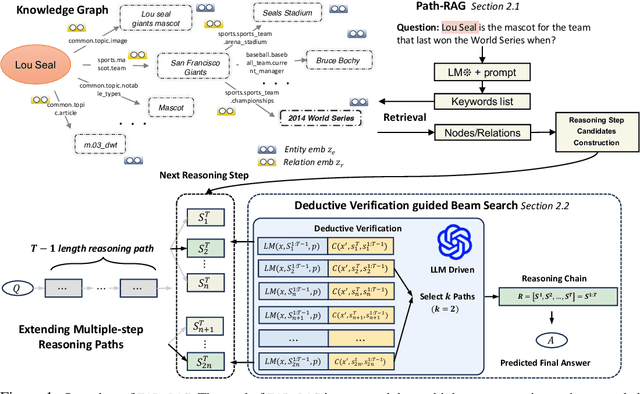



Abstract:While large language models (LLMs) have achieved significant success in various applications, they often struggle with hallucinations, especially in scenarios that require deep and responsible reasoning. These issues could be partially mitigate by integrating external knowledge graphs (KG) in LLM reasoning. However, the method of their incorporation is still largely unexplored. In this paper, we propose a retrieval-exploration interactive method, FiDelis to handle intermediate steps of reasoning grounded by KGs. Specifically, we propose Path-RAG module for recalling useful intermediate knowledge from KG for LLM reasoning. We incorporate the logic and common-sense reasoning of LLMs and topological connectivity of KGs into the knowledge retrieval process, which provides more accurate recalling performance. Furthermore, we propose to leverage deductive reasoning capabilities of LLMs as a better criterion to automatically guide the reasoning process in a stepwise and generalizable manner. Deductive verification serve as precise indicators for when to cease further reasoning, thus avoiding misleading the chains of reasoning and unnecessary computation. Extensive experiments show that our method, as a training-free method with lower computational cost and better generality outperforms the existing strong baselines in three benchmarks.
Advancing Graph Convolutional Networks via General Spectral Wavelets
May 22, 2024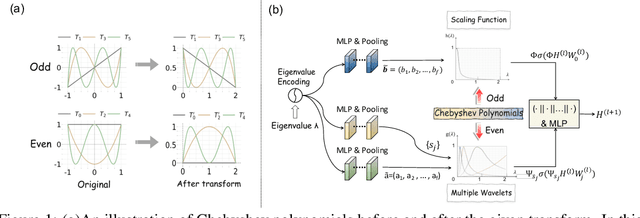


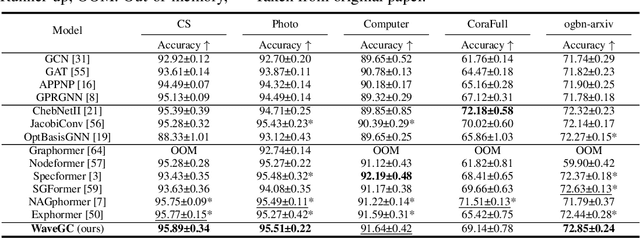
Abstract:Spectral graph convolution, an important tool of data filtering on graphs, relies on two essential decisions; selecting spectral bases for signal transformation and parameterizing the kernel for frequency analysis. While recent techniques mainly focus on standard Fourier transform and vector-valued spectral functions, they fall short in flexibility to describe specific signal distribution for each node, and expressivity of spectral function. In this paper, we present a novel wavelet-based graph convolution network, namely WaveGC, which integrates multi-resolution spectral bases and a matrix-valued filter kernel. Theoretically, we establish that WaveGC can effectively capture and decouple short-range and long-range information, providing superior filtering flexibility, surpassing existing graph convolutional networks and graph Transformers (GTs). To instantiate WaveGC, we introduce a novel technique for learning general graph wavelets by separately combining odd and even terms of Chebyshev polynomials. This approach strictly satisfies wavelet admissibility criteria. Our numerical experiments showcase the capabilities of the new network. By replacing the Transformer part in existing architectures with WaveGC, we consistently observe improvements in both short-range and long-range tasks. This underscores the effectiveness of the proposed model in handling different scenarios. Our code is available at https://github.com/liun-online/WaveGC.
Unsupervised Pre-training with Language-Vision Prompts for Low-Data Instance Segmentation
May 22, 2024
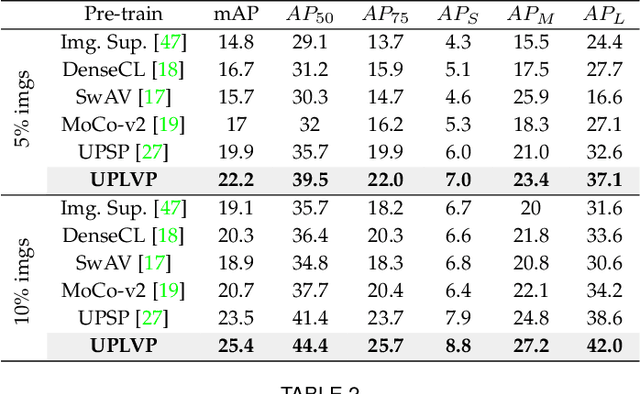


Abstract:In recent times, following the paradigm of DETR (DEtection TRansformer), query-based end-to-end instance segmentation (QEIS) methods have exhibited superior performance compared to CNN-based models, particularly when trained on large-scale datasets. Nevertheless, the effectiveness of these QEIS methods diminishes significantly when confronted with limited training data. This limitation arises from their reliance on substantial data volumes to effectively train the pivotal queries/kernels that are essential for acquiring localization and shape priors. To address this problem, we propose a novel method for unsupervised pre-training in low-data regimes. Inspired by the recently successful prompting technique, we introduce a new method, Unsupervised Pre-training with Language-Vision Prompts (UPLVP), which improves QEIS models' instance segmentation by bringing language-vision prompts to queries/kernels. Our method consists of three parts: (1) Masks Proposal: Utilizes language-vision models to generate pseudo masks based on unlabeled images. (2) Prompt-Kernel Matching: Converts pseudo masks into prompts and injects the best-matched localization and shape features to their corresponding kernels. (3) Kernel Supervision: Formulates supervision for pre-training at the kernel level to ensure robust learning. With the help of our pre-training method, QEIS models can converge faster and perform better than CNN-based models in low-data regimes. Experimental evaluations conducted on MS COCO, Cityscapes, and CTW1500 datasets indicate that the QEIS models' performance can be significantly improved when pre-trained with our method. Code will be available at: https://github.com/lifuguan/UPLVP.
Learning Social Graph for Inactive User Recommendation
May 08, 2024

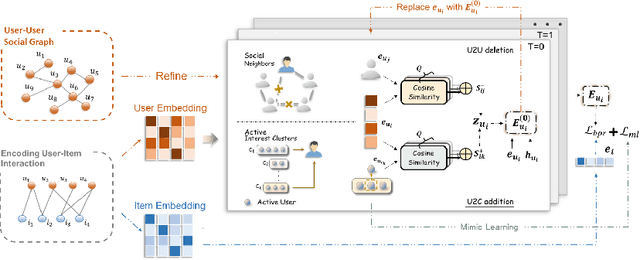
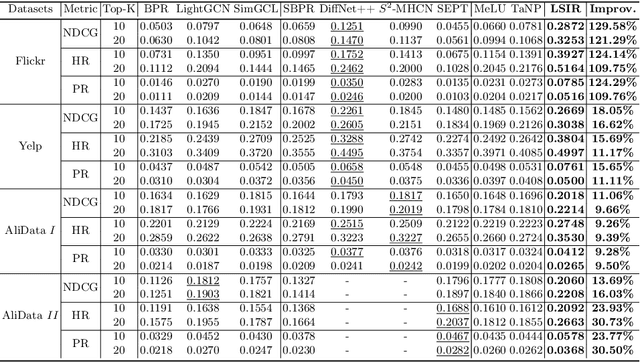
Abstract:Social relations have been widely incorporated into recommender systems to alleviate data sparsity problem. However, raw social relations don't always benefit recommendation due to their inferior quality and insufficient quantity, especially for inactive users, whose interacted items are limited. In this paper, we propose a novel social recommendation method called LSIR (\textbf{L}earning \textbf{S}ocial Graph for \textbf{I}nactive User \textbf{R}ecommendation) that learns an optimal social graph structure for social recommendation, especially for inactive users. LSIR recursively aggregates user and item embeddings to collaboratively encode item and user features. Then, graph structure learning (GSL) is employed to refine the raw user-user social graph, by removing noisy edges and adding new edges based on the enhanced embeddings. Meanwhile, mimic learning is implemented to guide active users in mimicking inactive users during model training, which improves the construction of new edges for inactive users. Extensive experiments on real-world datasets demonstrate that LSIR achieves significant improvements of up to 129.58\% on NDCG in inactive user recommendation. Our code is available at~\url{https://github.com/liun-online/LSIR}.
 Add to Chrome
Add to Chrome Add to Firefox
Add to Firefox Add to Edge
Add to Edge